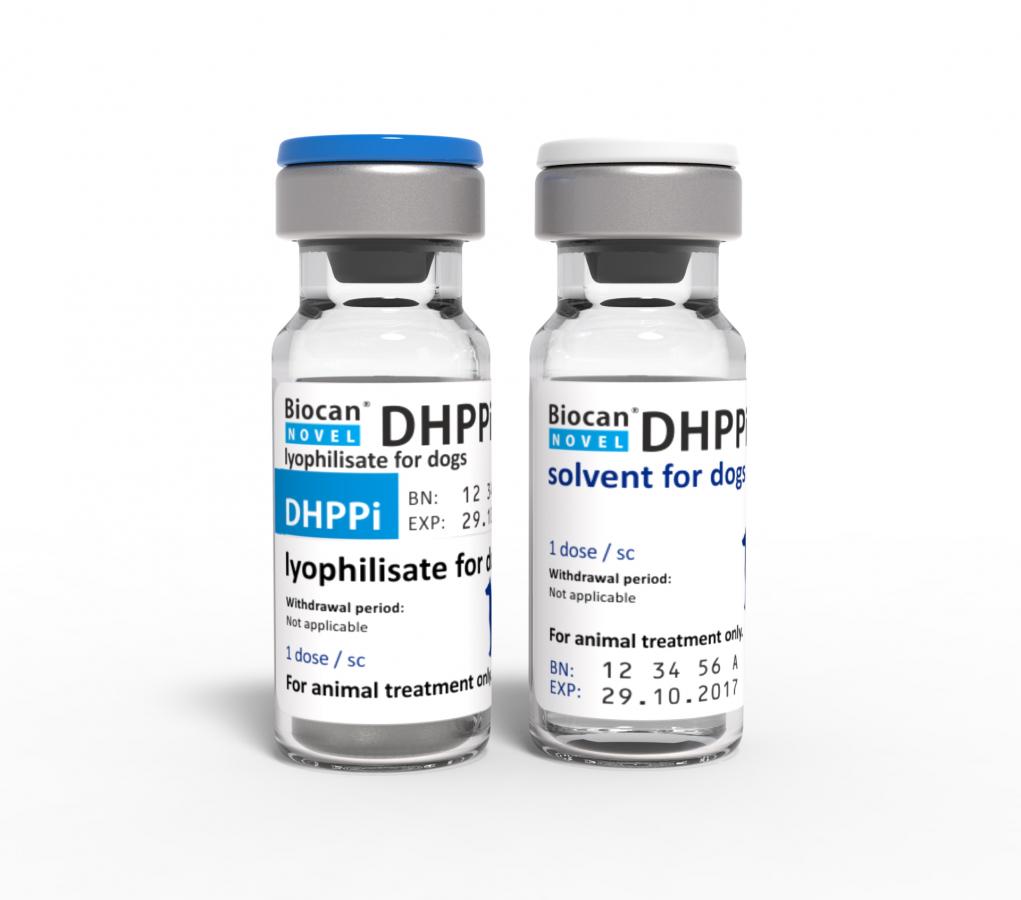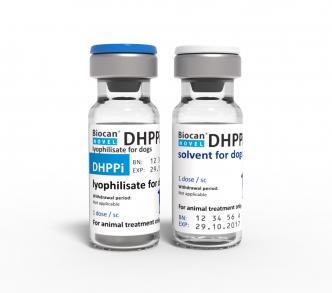Biocan Novel DHPPi, lyophilisate and solvent for suspension for injection for dogs
Homepage Products Veterinary products Biocan Novel DHPPi, lyophilisate and solvent for suspension for injection for dogs
Canine live vaccine against parvovirosis, distemper, inf. hepatitis, inf. laryngotracheitis and parainfluenza
| type of preparative: | Vaccines |
|---|---|
| target species animals: | Dog |
Composition per 1 ml dose:
Lyophilisate (live attenuated):
Canine Distemper virus, strain CDV Bio 11/A - min. 103.1 TCID50*, max. 105.1 TCID50*
Canine Adenovirus Type 2, strain CAV-2 Bio 13 - min. 103.6 TCID50*, max. 105.3 TCID50*
Canine Parvovirus Type 2b, strain CPV-2b Bio 12/B - min. 104.3 TCID50* , max. 106.6 TCID50*
Canine Parainfluenza Type 2 virus, strain CPiV-2 Bio 15 - 103.1 TCID50*, max. 105.1 TCID50*
* Tissue culture infectious dose – 50%
Pharmaceutical form:
Lyophilisate and solvent for suspension for injection.
Lyophilisate: Spongy matter, white colour. Solvent: Clear colourless liquid.
Target species:
Dogs
Indications for use, specifying the target species:
Active immunization of dogs from 6 weeks of age.
- to prevent mortality and clinical signs caused by canine distemper virus
- to prevent mortality and clinical signs caused by canine adenovirus type 1
- to prevent clinical signs and reduce viral excretion caused by canine adenovirus type 2
- to prevent clinical signs, leukopenia and viral excretion caused by canine
- to prevent clinical signs (nasal and ocular discharge) and reduce viral excretion caused by canine parainfluenza virus
Onset of immunity:
- 3 weeks after the first vaccination for CDV, CAV, CPV,
- 3 weeks after completion of the primary course for CPiV
Duration of immunity:
At least three years following the primary vaccination course for canine distemper virus, canine adenovirus type 1, canine adenovirus type 2 and canine parvovirus. At least one year following the primary vaccination course for canine parainfluenza virus.
The duration of immunity against CAV-2 was not established by challenge. It was shown that 3 years after the vaccination CAV-2 antibodies are still present. Protective immune response against CAV-2 associated respiratory disease is considered to last at least 3 years.
Contraindications:
Do not use in case of hypersensitivity to the active substance, or to any of the excipients.
Special warning for each target species:
A good immune response is reliant on a fully competent immune system. Immunocompetence of the animal may be compromised by a variety of factors including poor health, nutritional status, genetic factors, concurrent drug therapy and stress.
Immunological responses to the CDV, CAV-2 and CPV components of the vaccine may be delayed due to maternally derived antibody interference. However, the vaccine has been proven to be protective against virulent challenge in the presence of maternally derived antibodies to CDV, CAV and CPV at levels equal or higher to those likely to be encountered under field conditions. In situations where very high maternally derived antibodies levels are expected, the vaccination protocol should be planned accordingly.
Special precautions for use:
Special precautions for use in animals:
Only clinically healthy animals should be vaccinated.
The live virus vaccine strains CAV-2, CPiV and CPV-2b may be shed by vaccinated dogs for a number of days following vaccination. Due to the low pathogenicity of this strain, it is not necessary to keep vaccinated dogs separated from non-vaccinated dogs.
Since the vaccine virus strain CPV-2b has not been tested in domestic cats and other carnivores (except dogs) that are known to be susceptible to canine parvoviruses, it is recommended vaccinated dogs to be separated from other canine and feline species after vaccination. Faeces should be disposed of hygienically.
Special precautions to be taken by the person administering the veterinary medicinal product to animals:
In case of accidental self-injection, seek medical advice immediately and show the package leaflet or the label to the physician.
Adverse reactions (frequency and seriousness):
Following subcutaneous administration in dogs, a small transient swelling (up to 5 cm) may commonly be observed at the injection site, these can occasionally be painful, warm or reddened. Any such swelling will either have spontaneously resolved or be greatly diminished by 14 days after vaccination.
In rare cases gastrointestinal signs such as diarrhoea and vomiting or anorexia and decreased activity are possible.
As with any vaccine rare, occasional hypersensitivity reactions may occur. If such reaction occurs, appropriate treatment should be administered without delay.
The frequency of adverse reactions is defined using the following convention:
- very common (more than 1 in 10 animals displaying adverse reactions during the course of one treatment)
- common (more than 1 but less than 10 animals in 100 animals)
- uncommon (more than 1 but less than 10 animals in 1,000 animals)
- rare (more than 1 but less than 10 animals in 10,000 animals)
- very rare (less than 1 animal in 10,000 animals, including isolated reports)
Use during pregnancy, lactation or lay:
The safety of the veterinary medicinal product has not been established during pregnancy and lactation. Therefore the use is not recommended during pregnancy and lactation.
Interaction with other medicinal products and other forms of interaction:
No information is available on the safety and efficacy of this vaccine when used with any other veterinary medicinal product. A decision to use this vaccine before or after any other veterinary medicinal product therefore needs to be made on a case by case basis.
Amounts to be administered and administration route:
Subcutaneous use
Dose and route of administration:
Aseptically reconstitute the lyophilisate with the solvent. Shake well and administer immediately the entire content (1 ml) of the reconstituted product.
Reconstituted vaccine: Clear whitish to yellowish colour with light opalescence.
Basic vaccination scheme:
Two doses of Biocan Novel DHPPi apart 3-4 weeks apart from 6 weeks of age.
If protection against leptospira is required the second dose may be given with compatible product Biocan Novel DHPPi/L4 and the vaccination scheme planned accordingly (please refer to SPC for Biocan Novel DHPPi/L4).
Revaccination scheme:
A single dose of Biocan Novel DHPPi should be given every 3 years. Annual re-vaccination is required for Parainfluenza, therefore a single dose of Biocan Novel DHPPi or Biocan Novel Pi/L4 can be used annually if required. Full protective immunity against leptospira component of the Pi/L4 vaccine, if used for annual revaccination, is formed only after the basic vaccination with a Biocan Novel vaccine containing the L4 component.
Incompatibilities:
Do not mix with any other veterinary medicinal product.
Shelf life:
Shelf life of the veterinary medicinal product as packaged for sale: 2 years. Shelf life after reconstitution according to directions: administer the vaccine immediately.
Special precautions for storage:
Store and transport refrigerated (2 °C – 8 °C). Do not freeze. Protect from light.
Package:
10 x 1 dose










